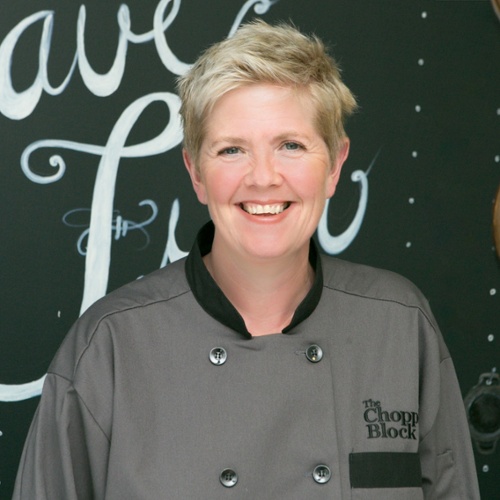My mom worked full-time and between work and taking care of four kids, it didn’t leave a whole lot of time for baking. We didn’t have a lot of money, so buying premade cakes and cookies was not an option. As an adult, I really admire and respect my mom’s ability to manage our money and prioritize how to spend it. But when I was a kid, I would have loved a Little Debbie snack cake or a Hostess Twinkie. They looked so delicious!
In late spring/early summer (i.e. rhubarb season) when I would whine to my mother that I wanted something sweet, she handed me a bowl of sugar and a stalk of rhubarb. I would sit out on the front porch with a giant bowl of sugar, dip the rhubarb stalk into the sugar and chew on the end of the rhubarb. I didn’t really eat the rhubarb but rather chewed on it like sugar cane, extracting the tart and aromatic juices that were sweetened by the steady stream of sugar I would mound on it. It certainly didn’t satisfy my desire for cookies and cakes, but it was uniquely delicious and the fact that my mother gave it to me with love made all the difference. In honor of Mother’s Day, I wanted to come up with a recipe to highlight that special memory.
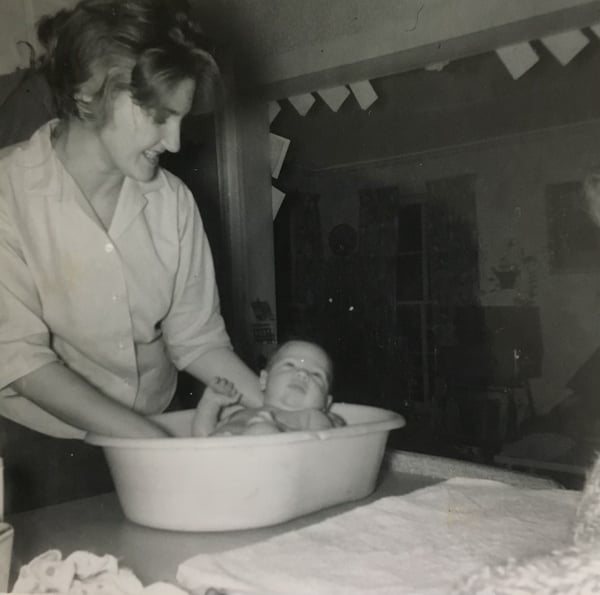 Rhubarb is truly delicious, but it isn’t an ingredient that people entirely know what to do with. I figured making a curd out of rhubarb would be a natural transition from the classic lemon curd and highlight the tastes I recalled sitting on my front porch as a kid. A proper lemon curd should make your mouth pucker much like rhubarb, but rhubarb also has a beautiful fruity and floral taste to complement its tartness.
Rhubarb is truly delicious, but it isn’t an ingredient that people entirely know what to do with. I figured making a curd out of rhubarb would be a natural transition from the classic lemon curd and highlight the tastes I recalled sitting on my front porch as a kid. A proper lemon curd should make your mouth pucker much like rhubarb, but rhubarb also has a beautiful fruity and floral taste to complement its tartness.
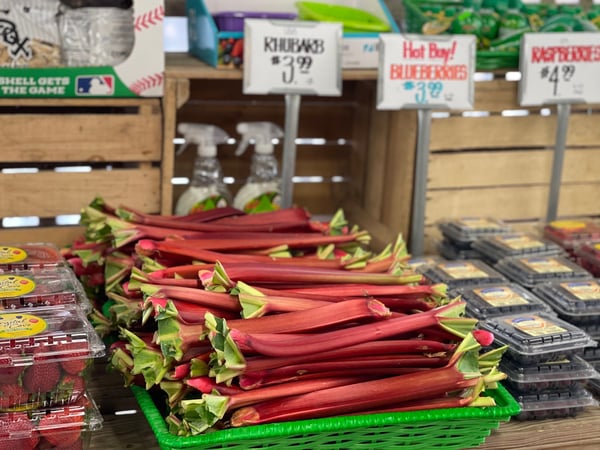 Lemon curd is made from the juice of lemons for flavor and tartness along with eggs to thicken, sugar to sweeten and butter to enrichen the curd. The resulting curd is tart, rich and velvety. I tried making the rhubarb curd at first by juicing the rhubarb and discarding all the fibrous strands from the stalks. The texture of the curd was just like a traditional lemon curd but the resulting curd lacked rhubarb color and flavor.
Lemon curd is made from the juice of lemons for flavor and tartness along with eggs to thicken, sugar to sweeten and butter to enrichen the curd. The resulting curd is tart, rich and velvety. I tried making the rhubarb curd at first by juicing the rhubarb and discarding all the fibrous strands from the stalks. The texture of the curd was just like a traditional lemon curd but the resulting curd lacked rhubarb color and flavor.
Ultimately, I opted to use the whole fruit, fiber and all and although the texture isn’t as velvety as a traditional lemon curd the resulting curd was loaded with rhubarb flavor. You will notice I added citric acid to the recipe, in my opinion the recipe really needed that additional pop of tartness and citric acid is the easiest way to add it. I do a lot of canning so I always have it on hand, if you don’t, try adding a little lemon juice instead, it won’t be as tart as this recipe is but it will still be delicious.
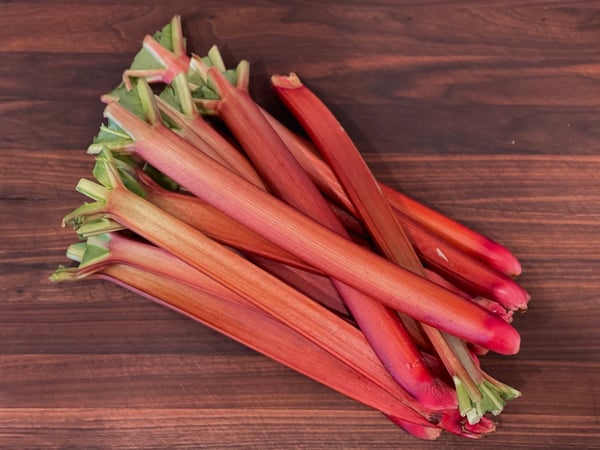
Rhubarb Curd
Scroll down for a printable version of this recipe
Yield: 4 Pints
Prep Time: 15 minutes
Cook Time: 10 to 15 minutes
Start to Finish: 2 hours
24 ounces rhubarb
2 cups granulated sugar
2 teaspoon kosher sea salt
1 tablespoon citric acid
8 whole eggs
6 egg yolks
1 1/2 sticks unsalted butter, cut into 1-inch pieces
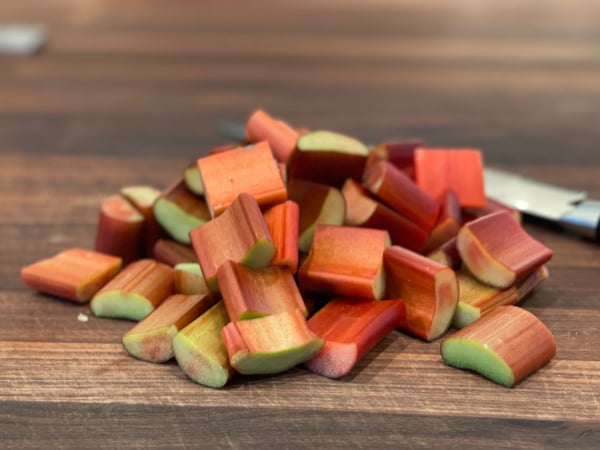 Step 1: Wash rhubarb, remove ends and leaves and cut into 1-inch pieces. Place rhubarb in a blender and puree until all the fibrous rhubarb strands are broken down and the mixture is smooth.
Step 1: Wash rhubarb, remove ends and leaves and cut into 1-inch pieces. Place rhubarb in a blender and puree until all the fibrous rhubarb strands are broken down and the mixture is smooth.
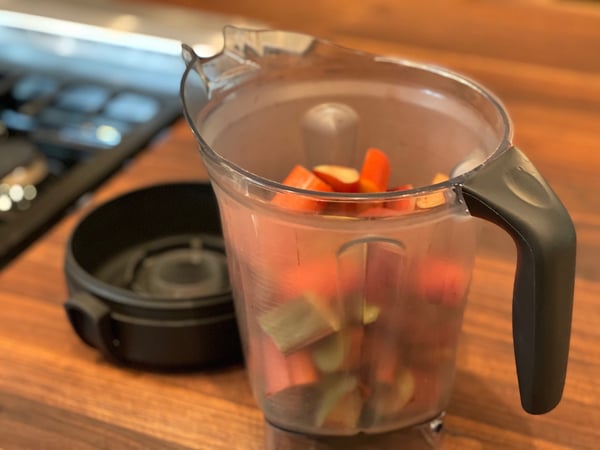 Please note: you cannot use a food processor for this, it will not break down the fibrous strands.
Please note: you cannot use a food processor for this, it will not break down the fibrous strands.
Step 2: Place rhubarb and all ingredients except butter into a large heatproof bowl. Place bowl and contents on top of a sauce pan filled with about 3 inches of water. Turn the heat to medium high heat.
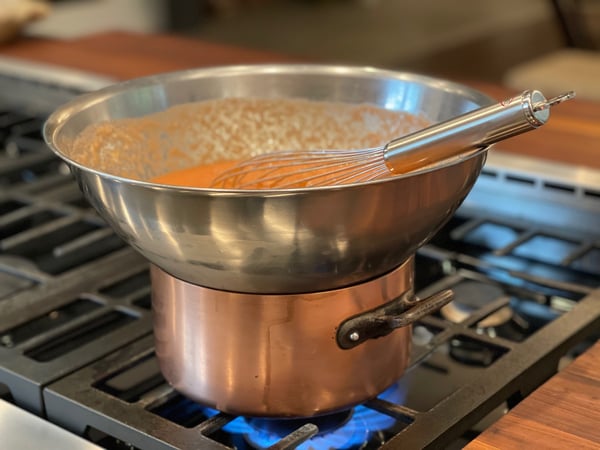 Step 3: Stir the mixture constantly with a whisk, scraping down the sides of the pan regularly with a rubber spatula. Cook for approximately 10 to 15 minutes until thick or until the digital thermometer reaches 160 degrees. Eggs are completely cooked at 160 degrees, so your mixture will not thicken further after that point. Turn off the heat.
Step 3: Stir the mixture constantly with a whisk, scraping down the sides of the pan regularly with a rubber spatula. Cook for approximately 10 to 15 minutes until thick or until the digital thermometer reaches 160 degrees. Eggs are completely cooked at 160 degrees, so your mixture will not thicken further after that point. Turn off the heat.
Step 4: Stir in the butter until just combined and remove curd from the stove.
Step 5: Immediately put the curd into 4 clean and sterilized mason jars and put the lids on. The jars should seal in about 15 to 20 minutes, you will hear a little popping sound when this happens. When you push down on the lid it shouldn’t bounce back, then you know the jar is sealed. By doing this your curd will last 4 to 6 weeks in the refrigerator. Chill at least an hour and a half before using.
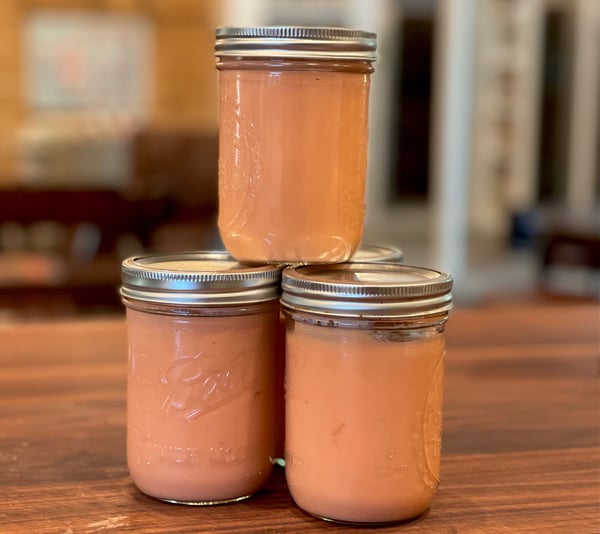 Please note: this recipe yields a lot, but can easily be cut in half if you choose.
Please note: this recipe yields a lot, but can easily be cut in half if you choose.
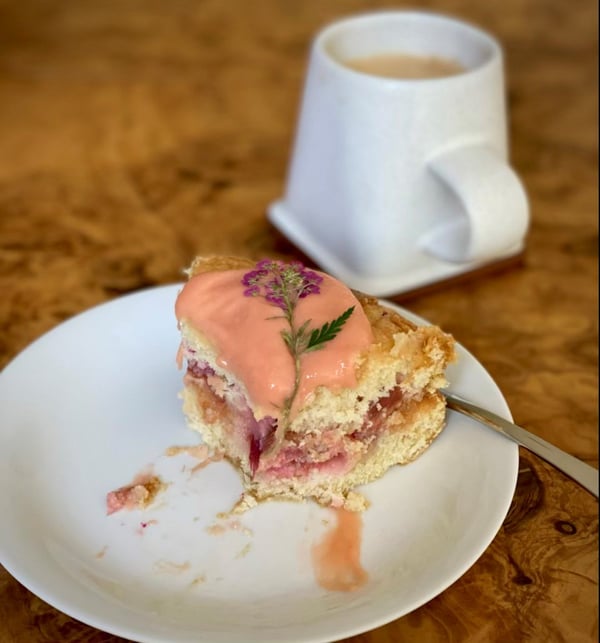 Try this curd loaded on buttermilk pancakes or strawberry-filled crepes. Use it as a filling or a topping for cake or simply spread on a scone. It can also be served on top of a beautiful bowl of berries or the berries atop the curd. This large batch is perfect for sharing with your favorite moms especially served up with a gift of a virtual class.
Try this curd loaded on buttermilk pancakes or strawberry-filled crepes. Use it as a filling or a topping for cake or simply spread on a scone. It can also be served on top of a beautiful bowl of berries or the berries atop the curd. This large batch is perfect for sharing with your favorite moms especially served up with a gift of a virtual class.
Want to do something special for your mom this Mother's Day weekend? We have both virtual and in-person classes to treat her!
- Mother's Day Hands-on in Provence Saturday, May 8 11am at Lincoln Square
- Mother's Day Spring Brunch Demo Sunday, May 9 11am at Lincoln Square
- Virtual Celebration of Bubbles for Mother's Day Sunday, May 9 3pm CST
- Virtual Mother's Day Dinner Sunday, May 9 4:30pm CST
Or give the gift of cooking to your mom with a gift card. They are good for classes (in-person and virtual) and retail. Have you heard our Lincoln Square store is back open for retail shopping? Come and see us, we'd love to see you!
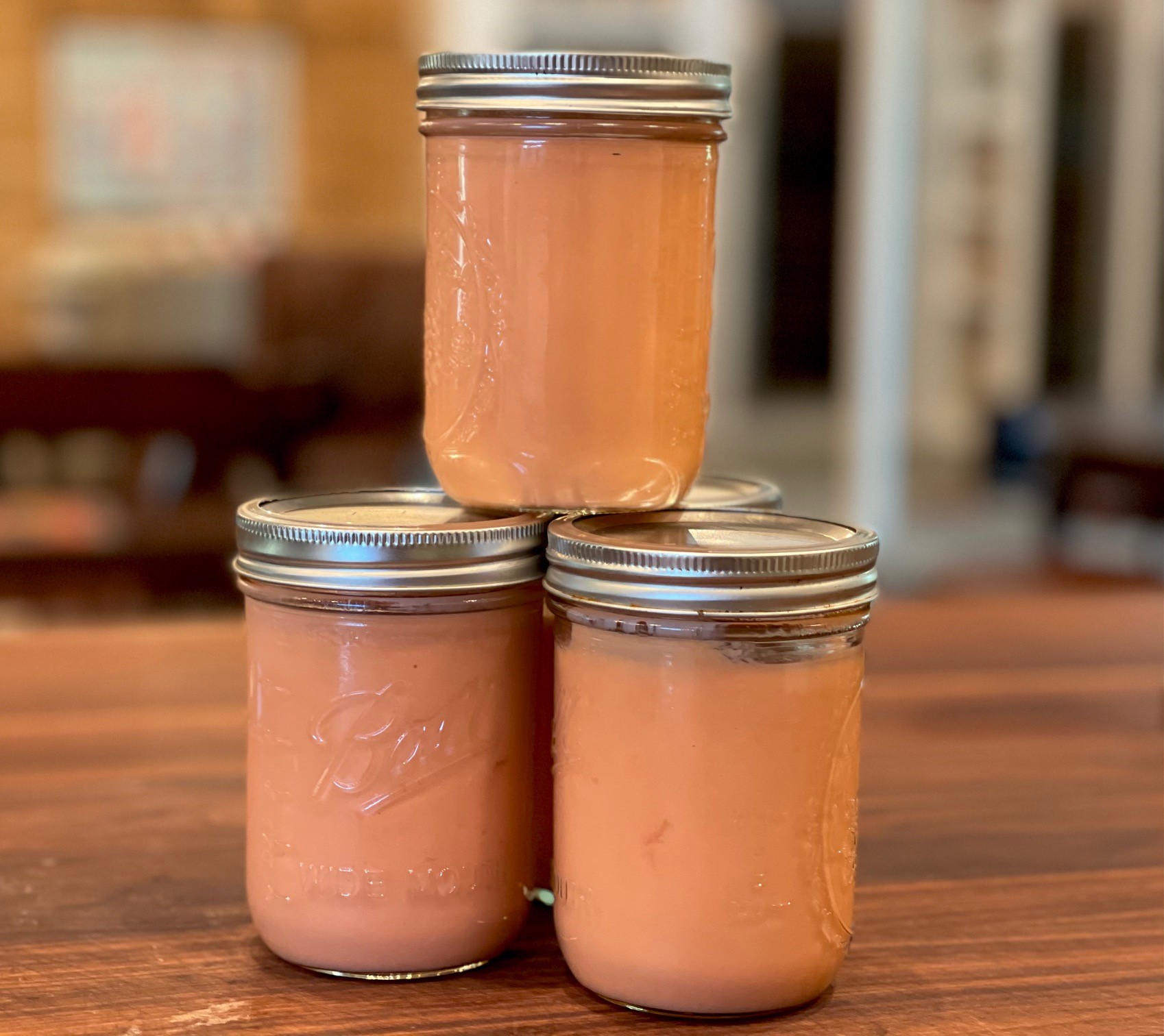
Rhubarb Curd
Ingredients
- 24 ounces rhubarb
- 2 cups granulated sugar
- 2 teaspoon kosher sea salt
- 1 tablespoon citric acid
- 8 whole eggs
- 6 egg yolks
- 1 ½ sticks unsalted butter, cut into 1-inch pieces
Instructions
- Wash rhubarb, remove ends and leaves and cut into 1-inch pieces. Place rhubarb in a blender and puree until all the fibrous rhubarb strands are broken down and the mixture is smooth.
- Place rhubarb and all ingredients except butter into a large heat proof bowl. Place bowl and contents on top of a sauce pan filled with about 3 inches of water. Turn the heat to medium high heat.
- Stir the mixture constantly with a whisk, scraping down the sides of the pan regularly with a rubber spatula. Cook for approximately 10 to 15 minutes until thick or until the digital thermometer reaches 160 degrees. Eggs are completely cooked at 160 degrees so your mixture will not thicken further after that point. Turn off the heat.
- Stir in the butter until just combined and remove curd from the stove.
- Immediately put the curd into 4 clean and sterilized mason jars and put the lids on. The jars should seal in about 15 to 20 minutes, you will hear a little popping sound when this happens. When you push down on the lid it shouldn’t bounce back, then you know the jar is sealed. By doing this your curd will last 4 to 6 weeks in the refrigerator. Chill at least an hour and a half before using.


